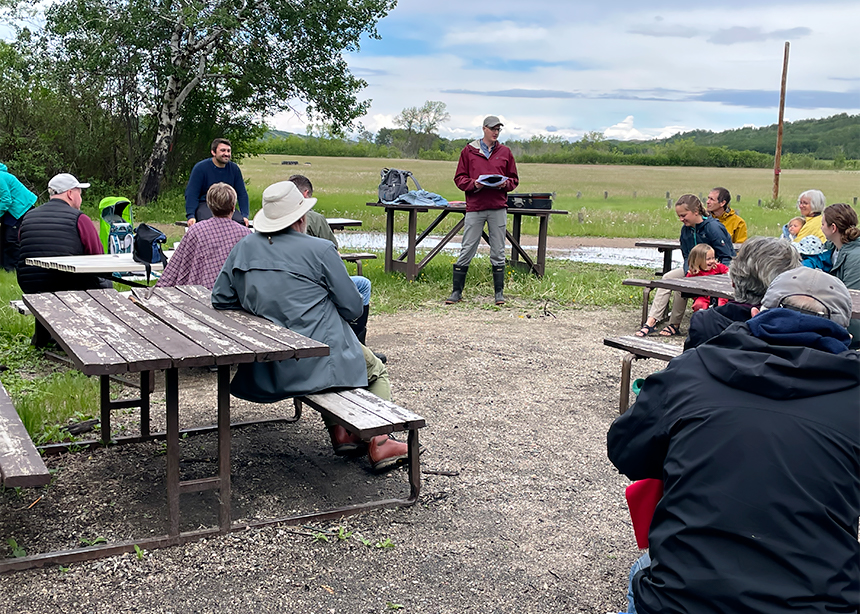Florence Driedger turns to look out the window before she replies to my question. “Well, we never know from one year to the next who and how many . . . whether we’ll still be functioning. We think we will be, but you never know.”
Uncertainty about congregational futures is nothing new. In my role as Mennonite Church Saskatchewan’s church engagement minister, I attract confessions of this uncertainty like a magnet. In the foyer after speaking in a local congregation or at a Mennonite Central Committee fundraiser, a church council member might pull me aside and say, “Josh, we’re just not sure how much longer we can keep going.”
What’s the source of this uncertainty? Usually it’s resources—specifically, a lack of them. The congregation is aging, members are moving to the care home, members are dying. Their kids haven’t come back to church. Shrinking numbers correspond to deficit budgets, reduced hours for the pastor, increased worry that the congregation is just a roof repair away from closure.
But it’s not just people or money that are missing; it’s also energy. The same handful of people fill every committee position, plan worship, look after the building. They’re exhausted.
Curtis Wiens, facilitator of Forest Church in Saskatchewan, names a question that amplifies all this: “If our congregation isn’t as robust and vital as it was, does that mean that God is no longer robust and active? Has God left the group?”
While Florence isn’t sure what the future may hold, she’s not anxious about her congregation. “Whether we are big or small,” she tells me, “it doesn’t mean that we are less faithful.” Her husband, Otto, also on the call, smiles and quotes Jesus: “Where two or three are gathered, there I am.” Otto says, “if there are two families, or three people, that’s where Jesus is too.”
Indeed, the congregation that meets in their Regina home, Peace Mennonite Church, faithfully welcomes an astounding array of folks from across continents and all sorts of social divides.
My conversations with Florence, Otto and Curtis are part of a larger project, two of eight conversations with congregations scattered across Mennonite Church Canada. Each congregation, in its own way, is charting a path through the surging seas of societal change and congregational anxiety. When I asked regional church ministers for leads on folks finding hope by doing church differently, I received stories from congregations in all five regions.
What I heard was less a potluck of how-to’s than testimonies of how congregations continue to meet a God who walks on the roiling waters. Curtis names something like this in reflecting on Forest Church, a monthly worship gathering that meets at Shekinah Retreat Centre. This gathering, he says, “declares something about God, who continually reaches out to us, regardless of the energy within the four walls of our [congregations].”
Initially I was surprised by the variety of shapes and formats these congregations took. I thought I’d be speaking mostly with young, missional entrepreneurs pushing the edges of what we think of as church. Instead, the majority of congregations I spoke with started before I entered grade school. One is just sneaking up on its hundredth anniversary. Some meet in homes, others in traditional church buildings, many virtually, one around a bonfire at a camp. A few arrived at their current format on purpose; most got there by just being willing to experiment and adapt. They’d make up a Venn diagram of overlapping clusters of congregations intentionally focused on young people and students, a number of house churches, communities making their home with folks pushed to the margins, and congregations finding creative workarounds to keep on keeping on.
Many of these congregations have concerns and hopes common to churches throughout MC Canada: “What do we do about buildings?” “How do we make decisions?” “How do we join what God is doing in our community?” While their varied responses don’t offer a roadmap out of uncertainty, they evidence how adjusting what we take for ordinary—where we meet, how we meet—can help keep us walking with the Spirit.
Bricks and mortar
Pastor Teresa Enns Zehr describes the history of a willing flexibility Aberdeen Mennonite Church has about buildings. When the Winnipeg congregation first organized in 1957, it already had a building. But aging brought a need for a more accessible space. In the early 2000s, they sold their facility and began to rent space from the nearby, more-accessible Trinity Lutheran Church. When the Lutheran congregation closed in 2013, they gifted their large facility to Aberdeen. But as the congregation’s needs shifted over the next years, they decided to return to being renters in the building, selling the building to St. Kateri Tekakwitha Catholic Indigenous Parish. Creative flexibility about space has allowed Aberdeen to remain present in their neighborhood.
Others navigate space in different ways. Many, like Peace Mennonite, Pembina Fellowship in Southern Manitoba, and SoulHouse in Scarborough, Ontario, meet in homes. Little Flowers Community in Winnipeg’s West End now meets in a home, but Jamie Arpin-Ricci tells me how it began as a used bookstore purposefully providing community gathering space in the city’s cold winter months. Still others, like Point Grey Inter-Mennonite Fellowship in Vancouver, have found space online that a physical building couldn’t provide. When their long-term rental arrangement disappeared just before the pandemic, virtual gatherings enabled them not only to continue worshiping together but also to open their virtual doors for homebound folks to return to the conversation.
Leadership
I spoke with many more lay leaders than paid professionals in these interviews. This is another thread: creative leadership. Otto Driedger from Peace Mennonite jokes that one benefit of lay leadership is low overhead. Fran Giesbrecht of Fort Garry Mennonite Fellowship in Winnipeg names other gifts of the model. He outlines how, inspired by early Anabaptists, pastoral care and other tasks of leadership are discerned within congregational K-(koinonia)-groups, including a rotating roster of five lay ministers. Fran says that being mentored into this ministry has been incredibly rich. “We have found that there are so many people who are pastors,” he says. Lay ministry recognizes and reawakens latent gifts of the Spirit.
And even among congregations with professional leadership, some are finding ways to rejig what that means. I hear the story of Springridge Mennonite Church near Pincher Creek, Alberta, where pastoral leader Tany Warkentin works 0.3 of a full-time position, focusing on facilitating worship, drawing in the gifts of others in the congregation and wider community.
Participation
This leads to a nearly universal theme among the congregations I spoke with: all members expect to participate in the work and the worship of the church. Fran says, for Fort Garry, this goes back to their origins in the late 1960s. The fledgling community said, “We are small, so we have to assume that every activity we have is going to be intergenerational, from babies to seniors, and when the church calls you, you’re probably going to have to say yes.”
Sandy Plett names a similar commitment to intergenerational involvement at Pembina Fellowship. She says she was drawn to this rotating fellowship of four house churches by its interactive, informal style and the fact that “kids are welcome and integrated and part of everything.” Ideally, this participatory spirit means individual gifts and passion have room to be known and to grow.
Travis Martin of Point Grey pictures his congregation as a “discussion.” Chan Yang, another member of Point Grey, says that it was just this spirit of conversation, enacted each Sunday in 15-minute discussions following the sermon, that drew him into the congregation.
This participatory, conversational model of being church shows up in the mentoring relationships Colin McCartney of Connect City in Toronto nurtures with young leaders in his under-resourced neighborhood. He tells me how these young people are already out there, “planting churches, doing mission . . . they just need to be apprenticed, equipped and resourced.” Connect City’s spiritual coaching keeps spinning out new “unique expressions” of church.
Decisions
Conversation also typifies decision-making in many of these churches. Fran remembers the meeting where Fort Garry decided to “promptly stop voting,” opting instead for a consensus-oriented discernment process. Some congregations, like Fort Garry and Aberdeen, build this method of making decisions into their board and committee structures. Others, like Pembina Fellowship and Forest Church, seek consensus through more informal conversations.
Teresa describes how Aberdeen employs sharing circles so that everyone has a chance to speak into decisions as they seek consensus. “At times that does feel slow,” she says, “but it’s sort of a ‘leave no person behind’ approach.” Veronica Dyck of Point Grey believes the slow process of making decisions together is “worth it,” avoiding the kind of power politics that end up hurting people.
Church service
Some congregations consciously identify themselves as a means of mission—Colin of Connect City tells me how we can’t “start with a church service, you start with mission.” Others view themselves as more of a sustaining community for members who are active outside the congregation. Sandy pictures Pembina Fellowship as “the potting soil around me”; she goes out and does her work, and the congregation is where she comes home to. “What God is doing in us,” she says, “is sustaining us, helping us care for each other.”
I hear Jamie of Little Flowers Community bring together these two themes, talking about his congregation’s motivation to address injustice. “There are barriers to belonging; we need to break down those barriers. . . . The primary vocation of the church is to be the rich soil of belonging in which things will take root and flourish according to their nature.”
In his book Churches and the Crisis of Decline, Andrew Root names how churches and denominations usually work from the assumptions that resources are what they need for life—that congregations need members, budgets, programs, etc. to weather whatever storms arise. Root pushes back with an alternative story: What brings life is God—and witnessing when God shows up. We can’t manipulate our resources to get God to show up. What we can do is wait. And it doesn’t take much to wait—just patience, flexibility, and a bit of hope.
That’s what I hear in these stories: hope. Also patience, a dash of bold creativity, and a lot of stubborn flexibility. Jamie shares with me a core motto of Little Flowers Community: “What we have right now is all we need right now for faithfulness right now.” Is there need? Surely, and a good deal of uncertainty, too. But, he says, “our faithfulness is not dependent on something we don’t have.”
This is no justification for battening down the hatches or dropping anchor where we are, to try to preserve the form of church we currently have. Sandy of Pembina Fellowship reminds me that “it doesn’t have to be forever to be real church; there are positives and negatives in every model.” We keep sailing. We keep taking the next steps, even when we know they might fail. Jamie closes our interview by encouraging MC Canada congregations to try new things before crisis forces us to. “It’s like when Peter got out of the boat,” he says, “he didn’t know he was going to walk on water. He had to do something that by every other standard he knew was going to fail.”
There’s no map out of these uncertain waters, but we step out in hope, beyond what we’ve assumed is the way church has to be, waiting to meet God walking toward us.
Josh Wallace is church engagement minister for Mennonite Church Saskatchewan. He can be reached at churchengagement@mcsask.ca.








Leave a Reply
You must be logged in to post a comment.